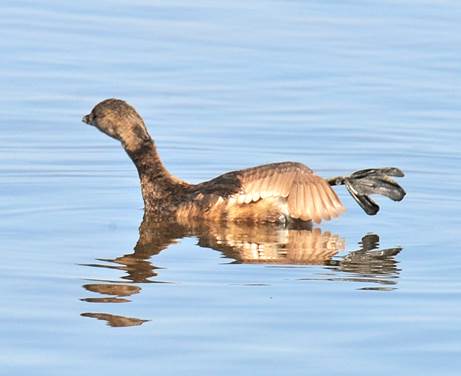There go the little Dobchicks, among the tall rushes and aquatic grasses that border the marsh. They have seen me, and now I watch them as they sink gently backwards into the deep water, in the manner of frightened frogs. Cunning things! “Water-witches,” as they call you, I clearly see your bills, although you have withdrawn all of you save those parts, and sneak off towards yon great bunch of bulrushes. —John James Audubon.
The poor pied-billed grebe. Often it is referred to as a “small, chunky, swimming bird” – not a particularly noble tag. But these birds do have compact bodies with a slender neck and a large, blocky head and a short, thick bill. In essence, they have no tail.
Their coloration is a bit dull – they are brown, slightly darker above with a more tawny shade on the underparts. During the summer the crown (top) and nape (back of neck) are dark and the throat is black. When breeding the bill is whitish with a black band (pied) but otherwise is more yellow-brown. Juveniles have striped faces. They are pretty small birds 11.5 – 15 inches long with a wingspan of 17.5 – 24.5 inches and tipping the scales at 9-20 ounces.
Pied-bills have the widest distribution of any grebe in the Americas and breeds from northern Canada through the West Indies and Central America. It is a common bird of freshwater marshes, lakes, and slow-moving rivers. In winters it can be found in brackish water.
These birds opportunistic feeders essentially eating anything they can get their bills onto including large crustaceans, frogs, fish, insects, and other invertebrates. Like other grebes, pied-bills eat large quantities of their own feathers, which at times fill up half their stomach. The feathers appear to form a sieve-like plug that prevents hard, potentially harmful prey parts from reaching the intestine. The feathers and indigestible prey body parts are formed into pellets and then regurgitated.
You don’t often see these birds in flight, in part because they migrate at night and land on the nearest body of water well before dawn. They will “crash-dive” to escape danger, kicking water several feet into the air. When they are hiding they may remain underwater with only eyes and nostrils just above the surface. Though chunky – they have reached the Hawaiian Islands, Europe, the Azores, and the Canary Islands.
The Latin Podilymbus – translates to essentially feet-at-buttocks (podic – rump and pes – foot) and kolymbos – diver –the species name podiceps – Latin for “rump-headed”, possibly referring to the blocky head shape(?).
Grebes do not have webbed feet such as ducks, but rather have webbing around each toe not fully connected to each other – called lobate webbing. They are efficient swimmers but because the feet are so far back beneath the body they can’t walk well on land.

Grebes construct an open bowl nest on a platform of floating vegetation such as a lily leaf, bulrush stems, or other plants. Both sexes build the nest, which can be completed in a day. Nests are hidden in taller vegetation. They will lay 2-10 eggs that are incubated by both parents for 23 days, covering it with vegetation if they need to both leave. Young grebes leave the nest within one day of hatching and spend much of the time on their parents back in the early days. Both parents feed and carry the young. They will live 10-12 years in the wild.

These are common birds in the Pacific Northwest. They can be seen all year at Green Lake, an urban park here in Seattle Green Lake Grebes
They have a variety of calls including a cackling-line chatter on display in this brief clip – Grebes calling Our office here in the Ballard neighborhood faces the Ship Canal between Lake Union and the Ballard locks and lately a pair of pied-billed grebes have been hanging out in the marina outside my office. Take a walk around some local waterways and you are likely to run into these small birds.
